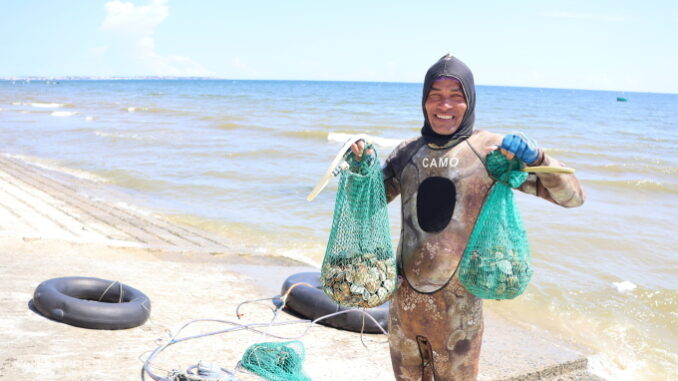
BINH THUAN – Mr. Mai Van Lam and more than a dozen fishermen in Phan Thiet City dive to catch sea clams, selling them for 150,000-200,000 VND per kilogram.
At around 8:00 a.m., when the sea was calm, Mr. Lam in Ham Tien ward tied a basket of clam diving equipment and a buoy to his old motorbike and drove to Mui Ne beach about three kilometers from his house. Upon arrival, Mr. Lam pushed the buoy into the water and placed the battery-powered diving machine on the buoy, then pulled it out to sea about 15 meters from shore.

Before that, this clam diving man tied a heavy lead around his stomach so that his body could easily sink when diving. Wearing goggles and holding a snorkel more than 5 meters long connected to an oxygen compressor powered by a battery, Mr. Lam dove into the water, holding in his hand an iron rod with a sharp tip about 3 gangs (60 cm) long.
Every 10-15 minutes, he rises up to rest, takes off his diving tube and breathes natural air again, as well as pours a few newly caught clams into the net basket on the float. “This job requires good health to do, soaking in water is very tiring,” Mr. Lam said.
When diving into the water, the fisherman pokes the sharp end of the iron rod into the sand to explore. Whenever he sees air bubbles escaping, he knows there are clams underneath the sand. He dug out 20-30 cm of sand, caught clams and put them in a mesh bag on his back. Just like that, he dived along the coast of Mui Ne – Ham Tien to hunt clams.
Every day he submerges himself in the water for about 6 hours, from 8:00 a.m. to 2:00 p.m. he takes his belongings to shore. Mr. Lam said that each diving trip catches about 5 kg of clams, selling for 100,000-200,000 VND per kg, depending on the size. On average, he earns 600,000-700,000 VND per trip.

At Rang beach, about 3.5 km away, Mr. Nguyen Nam, a fisherman from Ham Tien ward, had just dived nearly ten kilograms of clams. Taking off his swimsuit, he sat down to choose large and small clams and put them in two baskets. Large clams (size 25-30 pieces per kg) are nearly 4 kg, the rest are small clams (size 40-50 pieces per kg).
Mr. Nam cleaned up the floats, air compressors, and hoses, tied them neatly to his motorbike, and ran to the stalls to buy seafood to sell. Large clams are purchased for 200,000 VND, while small clams are purchased for 100,000-150,000 VND per kg.
“Today I won, I earned more than a million dong,” Mr. Nam said, adding that this job was endless. There were many days when the sea was windy and he could only catch a few dozen fish “enough to take home to drink”.
Phan Thiet fishermen said that clams live in the sand on beaches near the shore where the tides rise and fall. The beaches from Hoa Thang to Mui Ne and Phan Thiet have many large clams, so fishermen often dive to catch them. However, it is not every day that fishermen can dive to catch clams. They only dive when the sea is calm and the water is clear, because then they can see the clams clearly. On stormy days, they take a break and move on to other jobs.

Clams are bivalve mollusks, often living along tidal flats in the sea. Their food is plankton, algae and humus mixed in sand. Phan Thiet sea clams are usually glossy brown, light brown or white with brown stripes. The locality does not have clam farming, so most of the clams are caught from the wild.
Ms. Le Thi Be, a seafood buyer in Phan Thiet, said that clams caught in Phan Thiet sea have fatty, fragrant meat, and are sold by restaurants at a higher price than clams imported from other places. “Seafood connoisseurs know right away when they eat which clams are wild-caught or farmed clams,” Ms. Be said.
According to published studies, clam meat has many nutrients that are good for human health. Clam meat contains many nutrients such as protein, fat, vitamin B12, vitamin C, and many trace elements zinc, iron, potassium, calcium, manganese…
Buy live clams and soak them in clean water with a few slices of chili for two hours to release all the scum and sand. Clams are used to prepare many delicious dishes such as porridge, soup, stir-fried with lemongrass and chili, stir-fried with coconut, satay, steamed with lemongrass… Among them, steamed clams with lemongrass are the easiest to prepare and most popular in the coastal country of Phan Thiet.
($1=24,000 VND)
Photo,Video: Internet
